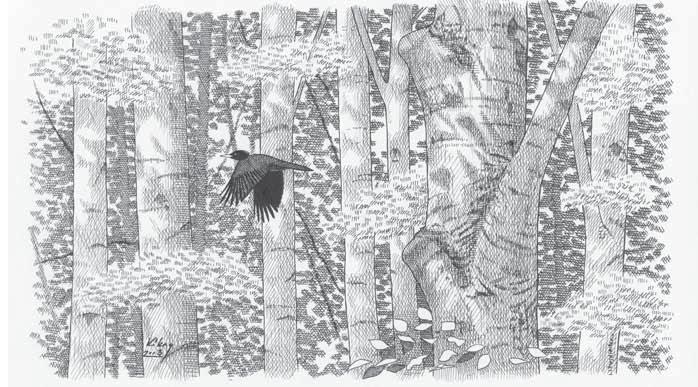
4 minute read
Black Woodpeckers in Suffolk? ............................................Phil Brown & Gerard Gorman
Contents
Editorial .......................................................................................................................................................1
Black Woodpeckers in Suffolk? ............................................Phil Brown & Gerard Gorman.................2 An eroding Suffolk coastline ................................................Richard Rafe.............................................5 Coda to a tailpiece .................................................................Gary Plank..............................................10 No-nonsense digiscoping......................................................Bill Baston, Danny Porter and Barry Woodhouse..................................10 Suffolk BINS –Spring –county rarities report ....................Roy Marsh..............................................15
Colour supplement Field Trip Reports
Orfordness ...........................................................................Val Lockwood.........................................17
Rutland Water.....................................................................Bill Stone................................................18
Brecks...................................................................................Gi Grieco.................................................20
Shingle Street .....................................................................Steve Fryett............................................21
Book Reviews
Norfolk Bird Atlas 2007.....................................................David Tomlinson....................................23
The Biggest Twitch.............................................................David Tomlinson....................................25 Looking back ...........................................................................Philip Murphy.........................................26
News from the reserves
Suffolk shoreline report ....................................................Alan Miller..............................................28
Announcements
New SORC Secretary...........................................................................................................................29
Chairman’s Report .............................................................Richard Rafe...........................................29
Members’ survey latest ....................................................Phil Brown..............................................30
Report Porpoise sightings.................................................Alan Miller..............................................31
Cover photography –
Digiscope photographer: Danny Porter Nesting on the old ice chute at Lowestoft harbour, this pair of Kittiwakes was digiscoped in March 2010. Shot details: f10, ISO 800, 1/1600 sec. Equipment: Canon EOS 500D and Swarovski ATS 80. Image sharpened using Adobe Photoshop.
Contact details for articles and observations are:
The Coach House, Denham Road, Dalham, Suffolk CB8 8UB. p.brown@doc-doc.com All material for the September 2011 Harrier should be with the editor by w/e 26 August
Website: www.sogonline.org.uk Email: info@sogonline.org.uk Suffolk Ornithologists’ Group Registered Charity No. 801446
The Harrier
Suffolk Ornithologists’ Group
Welcome to the latest Harrier
and the last of the re-design process –for the moment
As much as I enjoyed putting the last edition to bed, this quarter I have to open with an apology to several of its contributors, as a number of gremlins crept into print. But I can now confirm a proof-reader has volunteered to help and my trusty ‘spill chucker’ is now primed so that, hopefully, there won’t be a repetition in this issue (fingers-crossed).
That said I have buried one deliberate error in this bulletin. The reward for the winning finder will be a pint of bitter (or equivalent) on me in The Dove (Ipswich or Bury St Edmunds –depending which is nearer to the winner)!
Sea erosion is a centuries old problem for this county and so, with the publication of Suffolk’s Shoreline Management Plan late last year, it seemed appropriate to begin to consider the implications of this for Suffolk’s coastline. Thus in this issue we have the first of a two-part feature dealing with coastal erosion and its implications for reserves, birds and our birding experience.
On a more positive note, we open with an interview with a leading woodpecker expert on the possibility of Black Woodpecker breeding in Suffolk.
Even though, like most of us, I’ve tried digiscoping, it still remains something of a mystery to me and I thought it would be helpful if a couple of experts gave us the benefit of their thoughts; so in this issue you can enjoy the results of their labour on this Bulletin’s cover and in the colour supplement.
We are always on the look out for articles for the Bulletin, so if you’ve got anything you want to say, put it down on paper and send it to me (my address is opposite). Or, if you’re a photographer, send me some low-res shots of Suffolk landscapes for the next issue’s colour supplement. I’m intending this next supplement to illustrate all of the key Suffolk habitats, but with a twist, there has always to be a bird in the frame! Finally, scattered throughout this issue are a number of Su Gough’s warbler illustrations. For those of you of an artistic leaning perhaps you would like to submit some of your own work for the September issue? The theme will be waders.
Views expressed in The Harrierare not necessarily those of the editor or the Suffolk Ornithologists’ Group
Gerard Gorman in conversation with Phil Brown
The Black Woodpecker –its Suffolk potential
Ed.:Thanks for talking to me Gerard. First, for those of you who don’t know him (or haven’t read his recent Bird Watch article), Gerard Gorman is amongst Europe’s leading authorities on woodpeckers and he really knows this particular species well, as his monograph on it is being published this summer demonstrates.
Gerard, are we likely to see Black Woodpecker breeding in our lifetime in Suffolk?
Gerard:The short answer is, at best, possibly. There may probably have been the odd vagrant in the county over the years1 but, in the short-term, the odds are against it. As for the medium-term, who can tell? Black Woodpecker wouldn’t be the first species to confound the opinions of experts.
Ed.:But, as I understand it, this species has been expanding steadily westwards since the turn of the last century?
Gerard:That’s true. In the early 1900s Black Woodpecker was regarded as a Central
Editor:
Like many I’ve seen this impressive species of woodpecker from Estonia to Hungary and as far south as Cephalonia –and I’d very much like to see more. As Gerard Gorman has recently finished a monograph on this iconic woodland bird (which is featured in the June issue of Bird Watch magazine), I thought I’d take this opportunity to interview him about the possibility of our ever seeing it in Suffolk.
1 When I first discussed this matter with him, Gerard was already aware of a possible sighting of a Black Woodpecker at Benacre some years back.









